Fail fast.
Always be testing.
Hack your growth.
The mantras of many modern marketers.
I can’t stand them.
The problem with these terms is they make growth seem like it’s a simple 1-2-3 process or the result of some sort of underhanded campaign.
The truth is far different.
Growth comes from hard work and smart strategies.
But that’s not to say you have to fumble your way around in the dark.
How to Grow From Nothing
Forget about all the growth hacking, failure loving, test dependent methods of growth for a minute and answer this very simple question.
What are the only two things you need to make money?
The answer is as simple as the question.
You need…
- A quality product
- An audience who needs/would benefit from it
That’s it.
That’s all you need to start making sales. Forget about complex retargeting campaigns, convoluted funnels, or slick optimization tricks.
The secret to sales is nothing more than a combination of those two points.
The real question is how do you find killer products and the audience to sell them to?
1. Find In-Demand Products
At its core, the goal here is to find a customer pain point and a product to solve it.
As a rule, I’d say avoid any articles and suggestions like “Top Products of 20XX”. These are often focused on a developing trend, not on something that will provide a long-term source of revenue.
Finding the right product, whether you’re new to the game or expanding your product offering all begins in the same place.
2. Understand the Customer
You have to take a deep dive into your target audience to understand the problems they’re experiencing and how you can help solve them.
Let’s imagine you want to target the new mother market.
Before you think of any new products you should be going through as many new mom forums, FAQs, and reviews as possible.
Here’s what I got from a quick 5 minutes on Google:
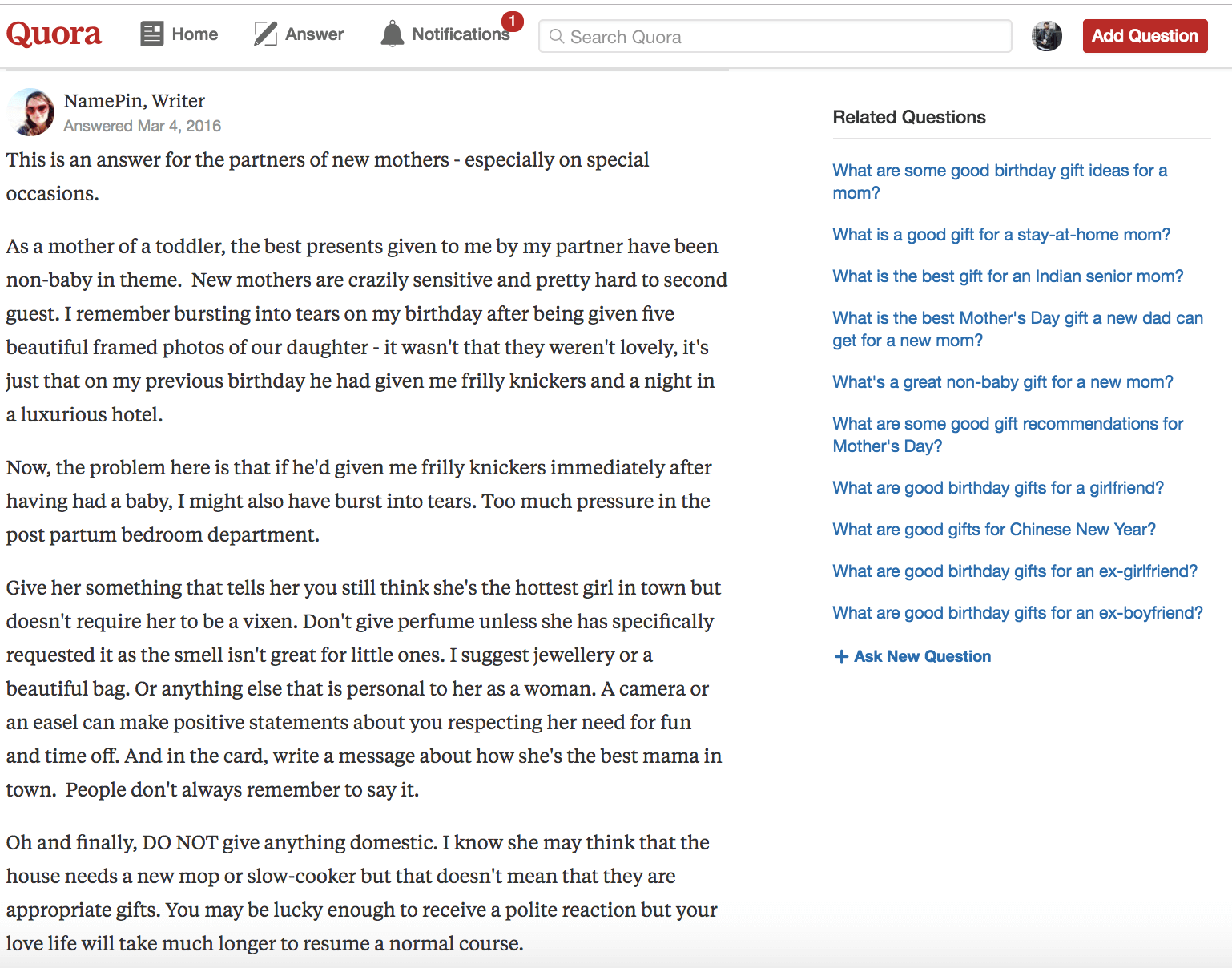
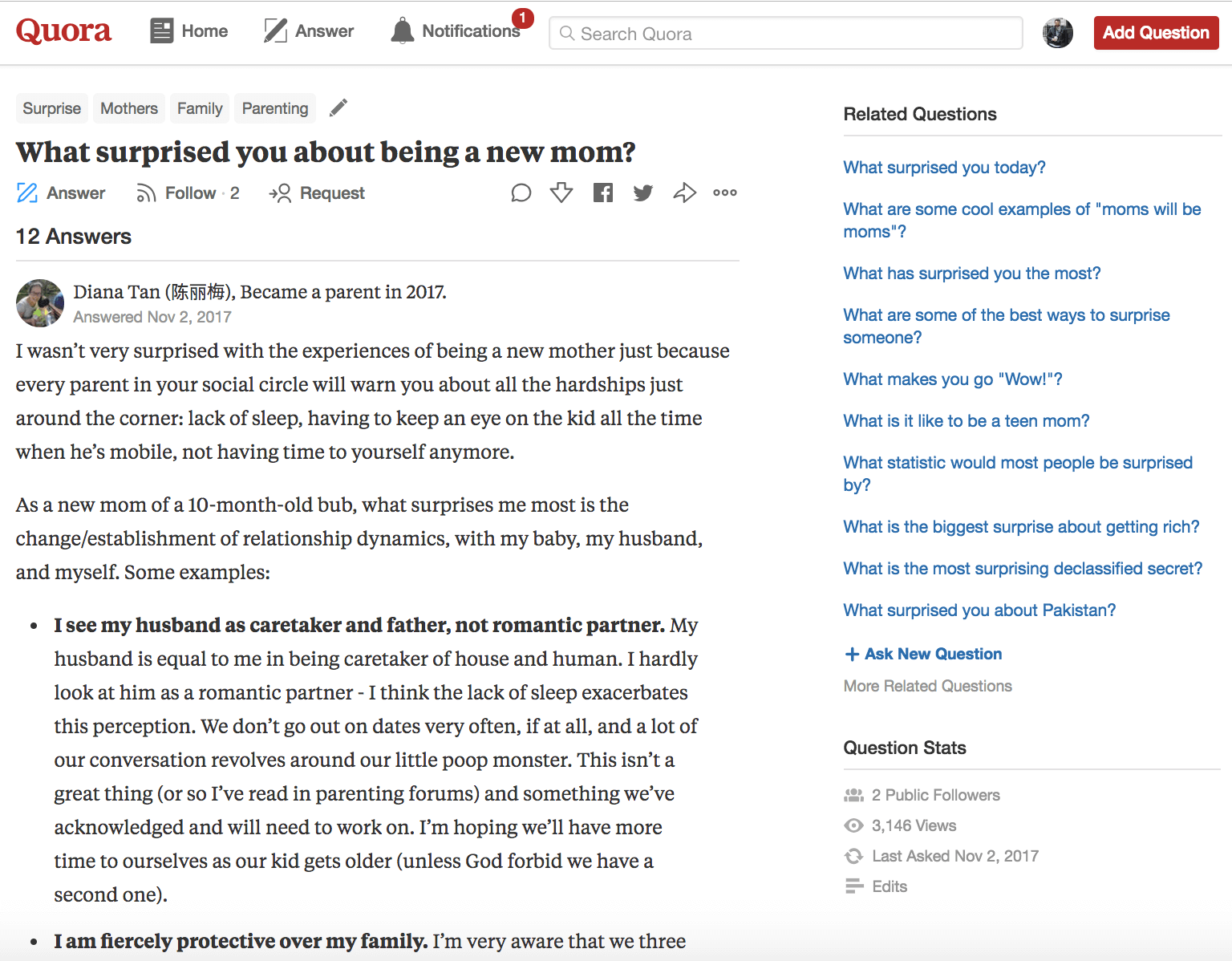
From these threads, I could generate a dozen or more ideas. I pulled both of these examples as they’re focused on gifts for the mom, not the kid.
If you check out the threads and read through some of the responses, a couple of starting points might be:
- Something to help new moms sleep
- Something to do with romance as new parents
- Diapers, wipes, etc.
- Comfort clothing like slippers, gowns etc
- Baby-feeding chairs
Once you’ve got a couple of seed ideas, you want to check to see the overall demand.
3. Identify Trending, Steady, or Growing Products
One of the biggest mistakes ecommerce professionals make is jumping on the bandwagon of the latest trending product.
Fidget spinners are the best example of this.
The massive boom they experienced in popularity saw a huge number of people rushing to sell them. But if you check out the search trends, you’ll see it was a flash in the pan.
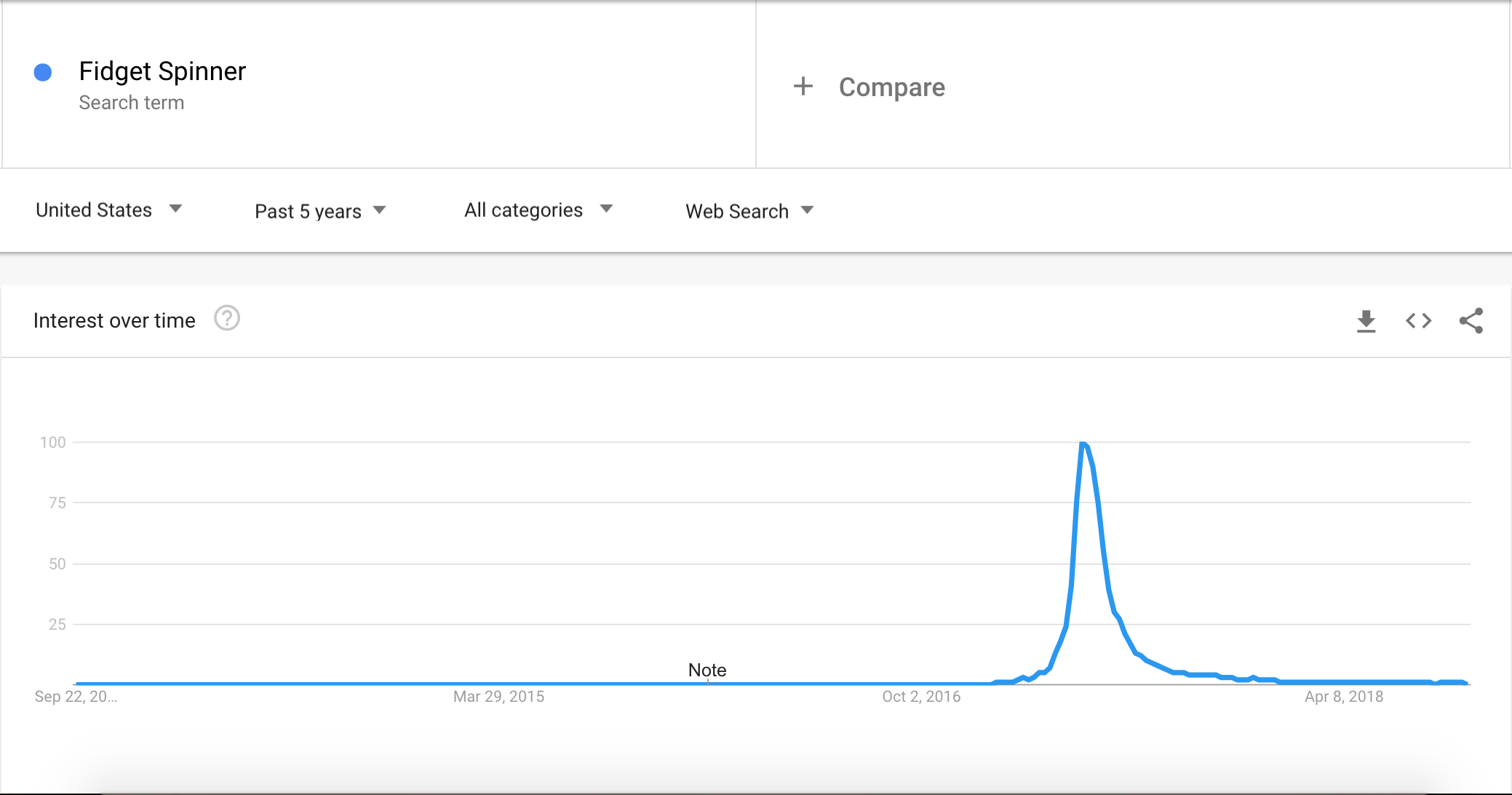
You have to find something for which there is demand now, but where there’s also going to be demand tomorrow.
Making a good number of sales in 6 months only to then see demand die off proves a quick end to your business.
You want an indication of interest that looks like one of the below:
1 – Staple needs – things that people will always need and will constantly look for. In the below case, I’ve kept with the new mom theme and looked for diapers, as they’ll always be necessary.
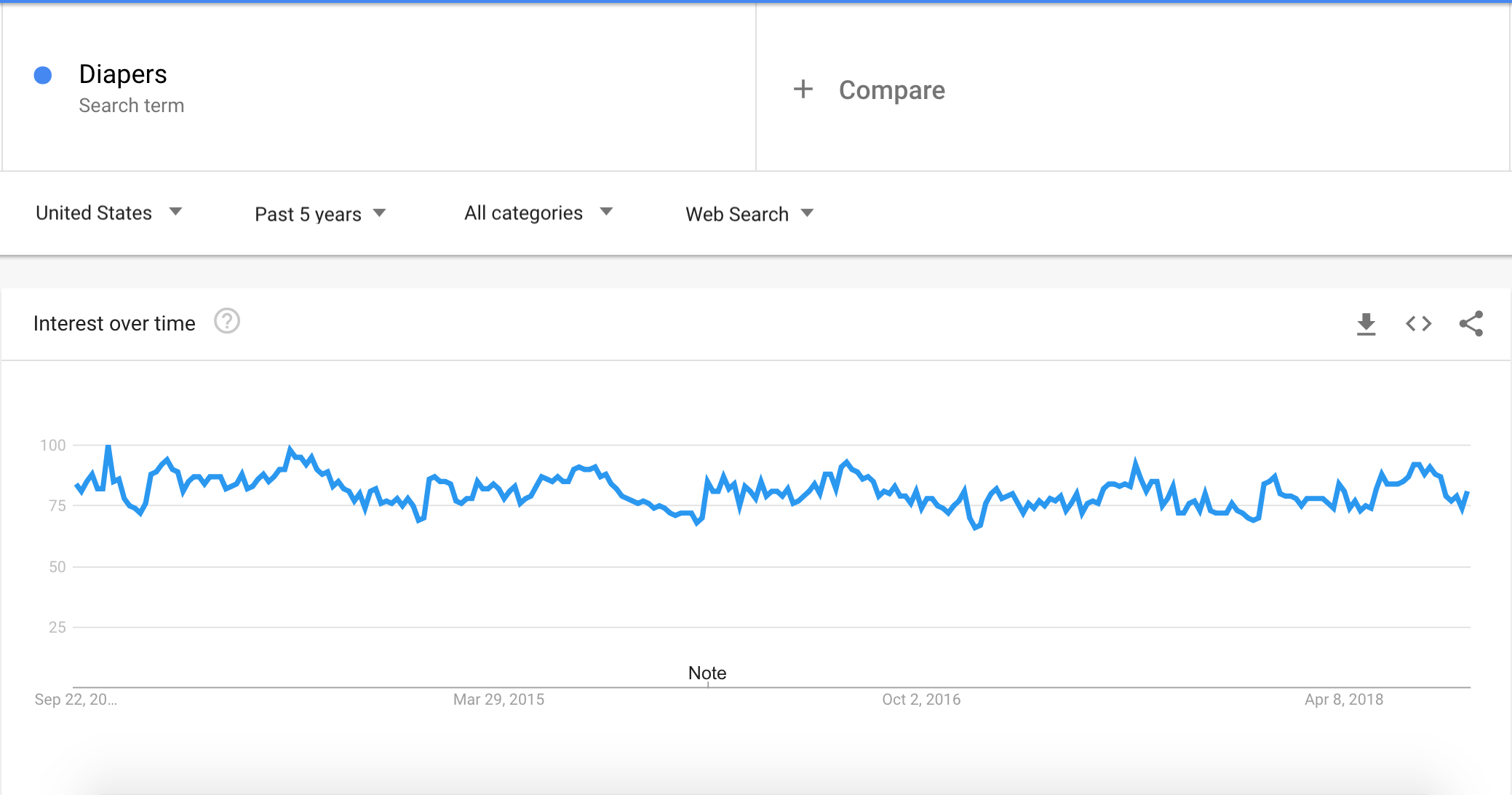
2 – Products with steady growth – Those which started off as a trend, but have the staying power and are continually rising in popularity with no signs of disappearing.
The below is a check on “Keto Recipe” (I’ve had to leave the baby market here, unfortunately, as there are a ton of steady, but few growing, products) which could be used as a jumping off point for diet products and materials.
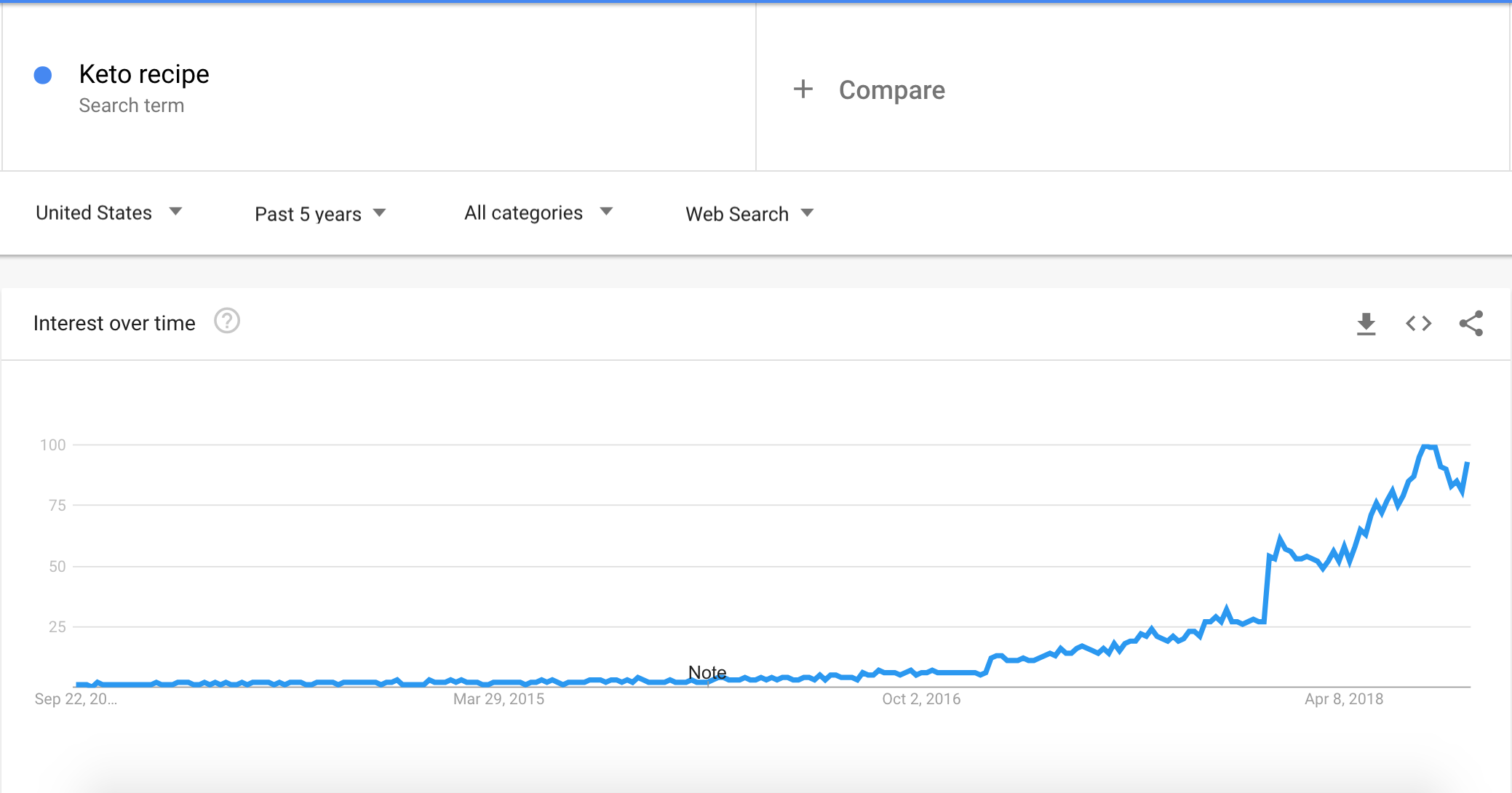
4. Determine Market Demand
There’s a big difference between the ideas you pull from the internet and what’s going to sell.
What you now have to do is go to Google’s Keyword Planner to figure out the commercial viability of those products.
In the image below, you’ll see the results when searching for “Diapers”:
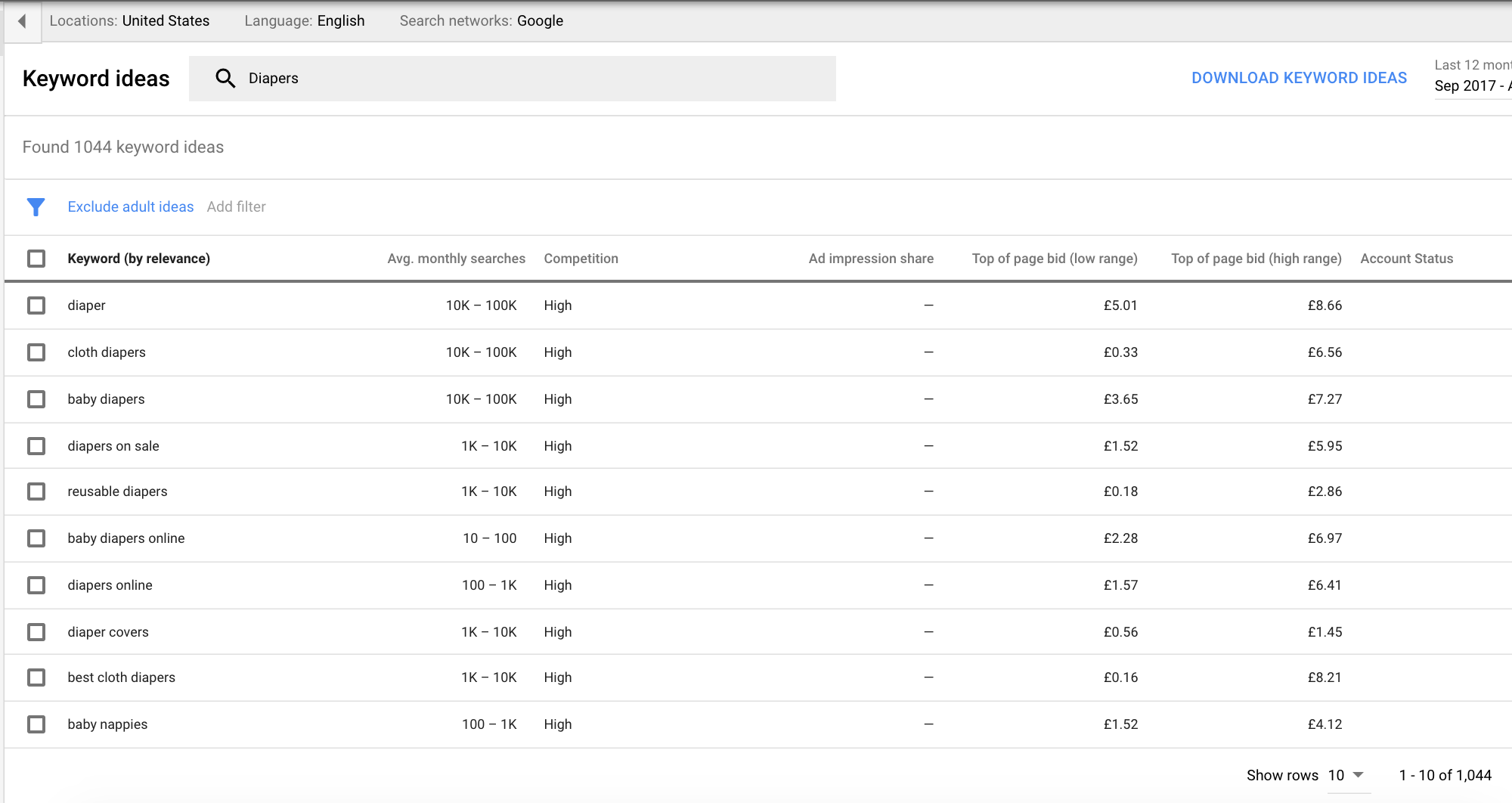
There’s a couple of things you’re going to want to look for here:
- Average Monthly Searches – The higher the number, the more people are searching for it. However, don’t think searches alone indicate interest. I’ll show you how to confirm commercial viability shortly.
- Long Tail Keywords – This is great for ideas. “Diapers” is too broad, and as many a marketer is fond of saying, “the riches are in the niches.” So maybe something like cloth diapers, reusable diapers, or some combination of the two will resonate better with an engaged and proactive audience.
- Top of Page Bid – Search traffic alone isn’t enough. You need to know if there is the potential to sell the product. This is where the top of page bid comes in. Generally speaking, the higher the top of page bid, the more economically viable the keyword and product. The reason some terms have a higher bid is that they’re more likely to garner a sale. So you want to look at both high traffic and high CPC bids. The two together indicate interest and purchase intent.
Ok, so going through this process should take no more than an hour and should give you a couple of product ideas to run with. The next step is to get real data and see what sells best.
For that, you’re gonna need some help.
5. Drive Sales Through Influencer Marketing
You’re likely not going to have an audience for this new product yet, which makes it difficult to judge its actual profitability.
Instead of throwing loads of money at paid ads or promotions, partner with someone who has an audience and ask them to promote it for a commission or freebie.
There’s a great guide here on how Tim Kock built a dropshipping store using influencer marketing as part of his strategy. I’ll lay out the basics of the strategy here though.
Tim went through Instagram and found people in his niche who shared his target audience.
Then, all he did was send them a quick message asking for feedback on his products and store:
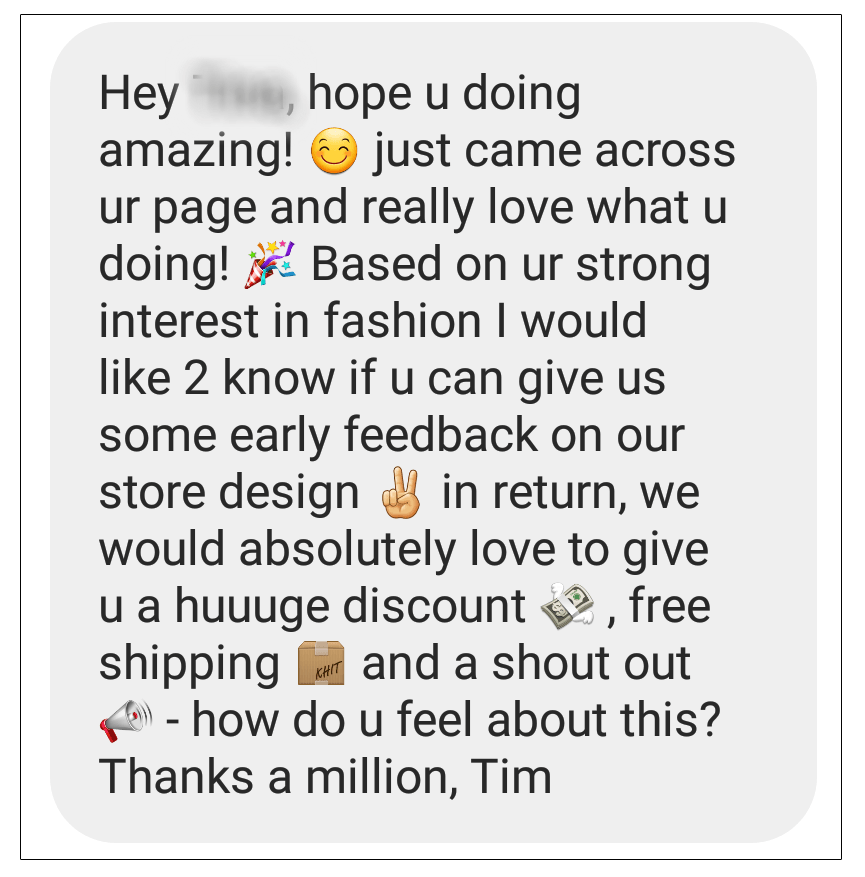
When Tim got a positive response, he followed up as promised:
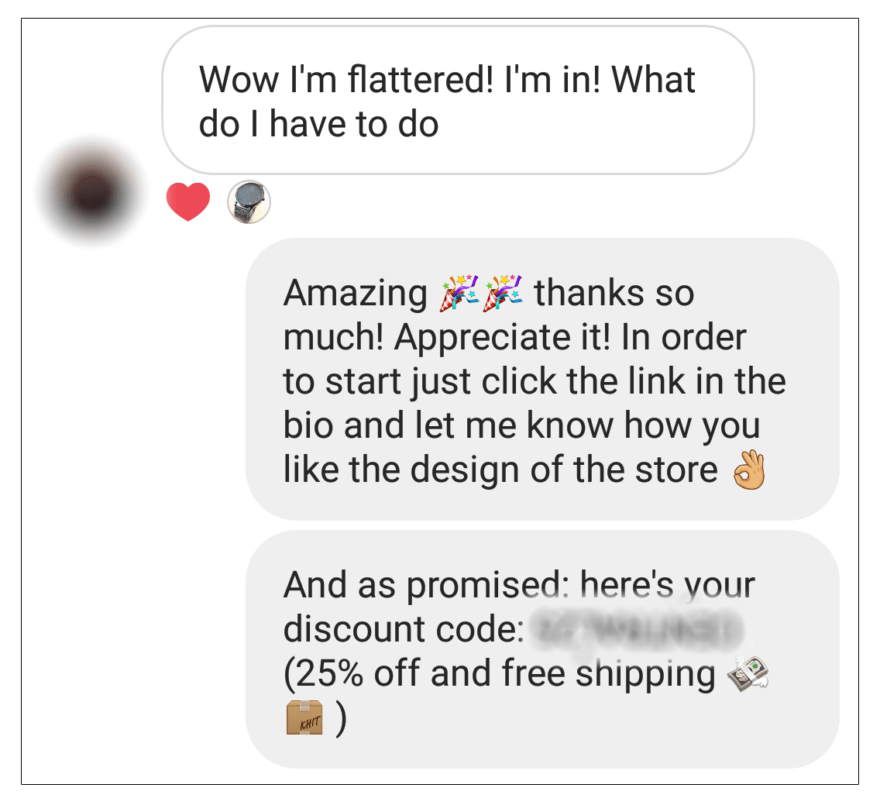
Tim then doubled down on this direct outreach method and asked micro influencers to promote the product to their audience in return for a free product of their own.
Here’s an example of the Instagram shout-outs he received:

In just under 2 months Tim managed to create a store that made over $5000. Not bad, hey?!

This method of direct outreach is the quickest way to get initial sales in. And once people have bought from you once, it’s pretty easy to sell your next product to them.
However, it’s not all you can do.
6. Kick Influencer Marketing into Overdrive
Influencer marketing through direct outreach is one of the quickest ways to reach a large, interested audience.
However, you can go a step further and increase success by streamlining the purchase funnel.
If you’re running a store and approach an influencer, the general purchase journey will look something like this;
Prospective customer sees influencer’s post > is redirected to product page > adds product to cart > proceeds to checkout page > completes checkout and sees confirmation page
It’s a lot of steps, each one throwing potential friction into the journey.
The easiest way to reduce those steps and subsequent friction is to make use of chatbots.
7. Use Chatbots in your Abandoned Cart Strategy
Chatbots will reduce the number of steps a user has to take to the bare minimum. They’ll stop users having to redirect their journey to your store instead of completing it on the platform they found your product on.
They are, quite simply, an easier way of purchasing.
Related Reading:
To learn more about how you can implement chatbots on your website, check out Wishpond’s How Expensify Got 5X More Customers with Chatbots.
When running the numbers of chatbots vs the current ROI king of email, the guys at ChatBotsLife came up with the below breakdown:
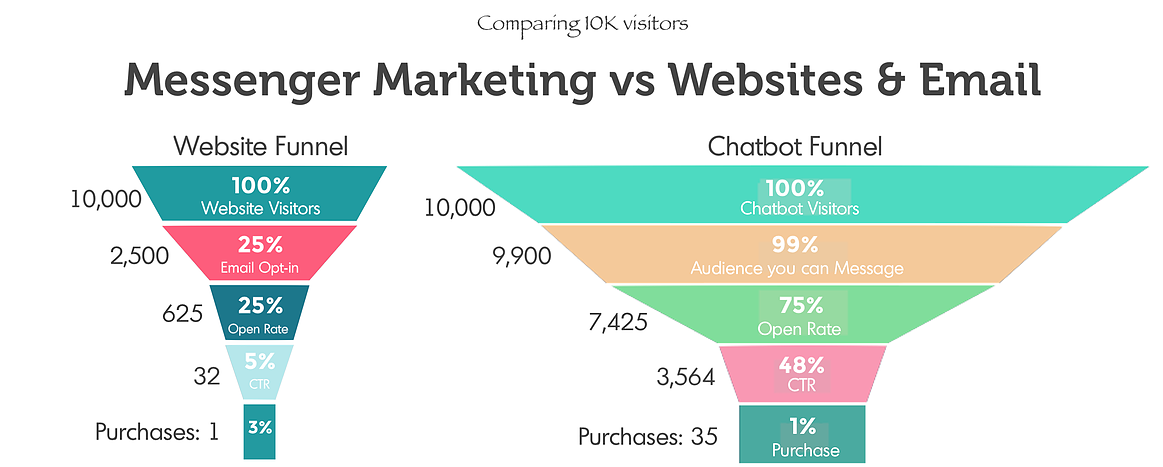
Chatbots, Messenger Marketing, and Conversational Commerce are completed outstripping the more traditional methods of marketing.
The question now shifts from why use automated checkout bots in your funnel to how best to implement them.
One of the easiest ways is with jumper.ai.
The setup takes just a few minutes to set up a purchase journey that, from the user’s perspective, looks something like the below:
It’s a simple, easy way to drive sales directly through social media.
However, there’s a couple of things you should note before getting too carried away.
8. Maximize Profit with Messenger Marketing
I am, of course, extremely biased.
I can count 2 Messenger Marketing companies among my clients which has given me a front-row seat to the incredible results conversational commerce can provide.
However, I’ve also seen the weaknesses within the Messenger platform. I’m not going to lie to you here and say that Messenger Marketing is the solution to all your ecommerce woes. However, if you know how to leverage it properly, it can provide long-term benefits for your business.
The first thing to note is what Messenger Marketing is good for and the areas in which it excels.
Generally speaking, you’ll want to limit your Messenger campaigns
transactional messages (like abandoned cart, quick welcome messages, receipts etc).
Messenger far outstrips email when it comes to the biggest problem in ecommerce, cart abandonment.
The problem with relying solely on cart abandonment emails is you’re left at the mercy of things like spam folders, promotional content filters, and an ever-expanding inbox.
With Messenger there is no spam folder, no promotion tab, and it’s a channel which people associate with communicating with friends and family members. This drastically increases the number of opens, clicks and sales.
Recart studied the numbers of email vs Messenger and saw a huge improvement in all key metrics when focusing on Messenger.
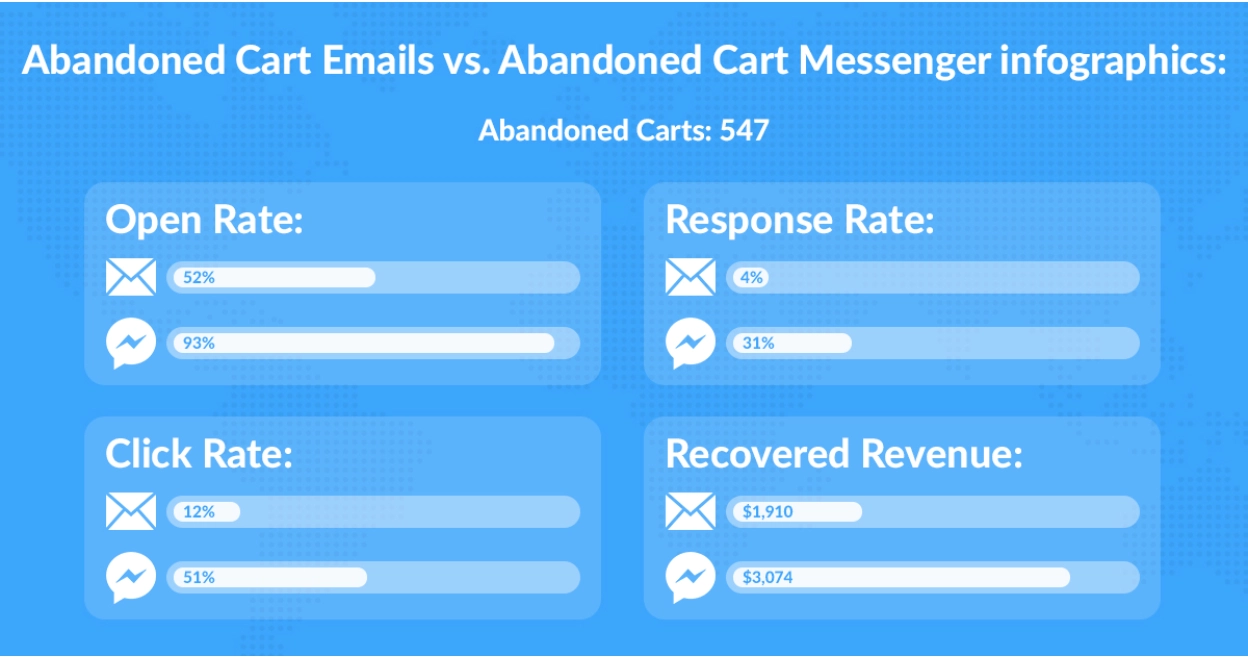
Messages like welcomes, cart abandonment, and receipts are succinct and to the point. No one wants to have a full-text email come through explaining what they left in their cart or the receipt for their recent purchase.
Messenger feeds the user’s desire for a short, quick message. It’s quick to outline the key points and is more in line with the modern user’s busy lifestyle which is why, for simple things like cart abandonment, it is far more productive.
9. Integrate Messenger Marketing with Email Marketing
But, messenger bots will never beat email when it comes to long term nurturing.
Social commerce is not a replacement for email, but an addition to your email marketing campaigns.
If, for instance, you’re selling a $500 pen, you’re going to need a decent level of trust, right?
That’s where email comes in.
Say you introduce a website visitor to your business through a high-quality article covering all the pros and cons of expensive pens over cheap ones. They’re interested, but not ready to lay $500 on the line. But they do submit their information to get your Complete Guide to Pens.
Over the next few weeks, you send them awesome pen-related articles and guides. And you introduce yourself and your brand. You talk about awards your pen has won and show them 5-star pen reviews. They start to trust you.
Then, when they’ve received all these emails and visited your pen’s product page one more time, you send them a final email letting them know that, now until midnight, they can get 20% off their first purchase (with free shipping!)
What I’m trying to say is you have to look at social commerce in terms of how it can improve your existing marketing efforts. It’s not a replacement, but an addition.
10. Implement This Simple, Two-Step Process
Don’t overcomplicate things.
All you need is a way to advertise to your ideal audience and a decent, low-cost product they won’t think twice about paying for.
That initial purchase isn’t going to be your money maker, but it is going to get people familiar with your brand and start building the trust you need for repeat, bigger ticket sales.
The real secret here is hustle though.
You’ve got to create or find that key product on your own. You’ve got to forge those relationships with influencers so they’re willing to promote it to their audience which, in turn, will grow yours.
Don’t overcomplicate things by following all the generic advice out there.
Simply find a product that solves a problem, and work your ass off to get it in front of those who will benefit from it.
As mentioned, the easiest way to do this is through social media. And I’d give an (obviously biased) recommendation to do so with a free account at jumper.ai.
Author Bio:

Pete Boyle is the founder of Have-a-Word and chief copywriter of jumper.ai, the Social Commerce platform that allows brands to sell through every social media network with just a few clicks.
Related Articles:
- A Complete Walkthrough to the Most Essential eCommerce Marketing Tactic
- 6 High-Quality Product Landing Page Designs & Tools to Use
- 5 Expert Ways to Increase Your eCommerce Customer Service
- 6 Best Contest Emails & What You Can Learn From Them
- 5 Ways Digital Transformation Can Drive Your eCommerce Business

